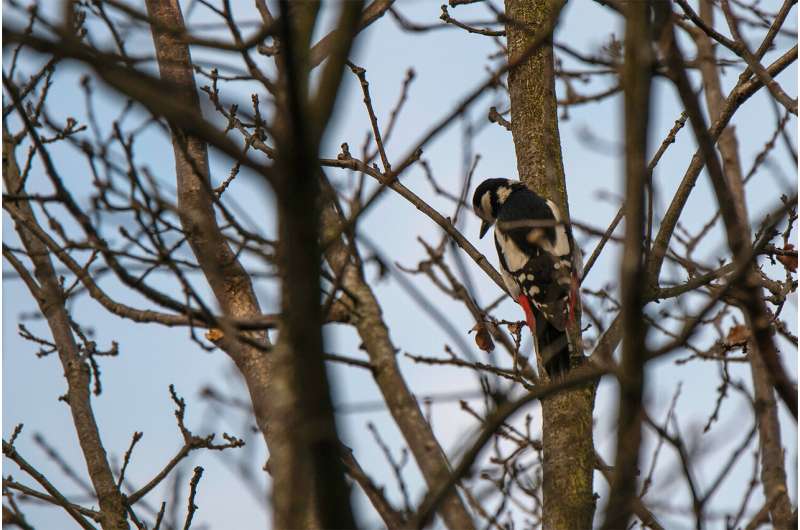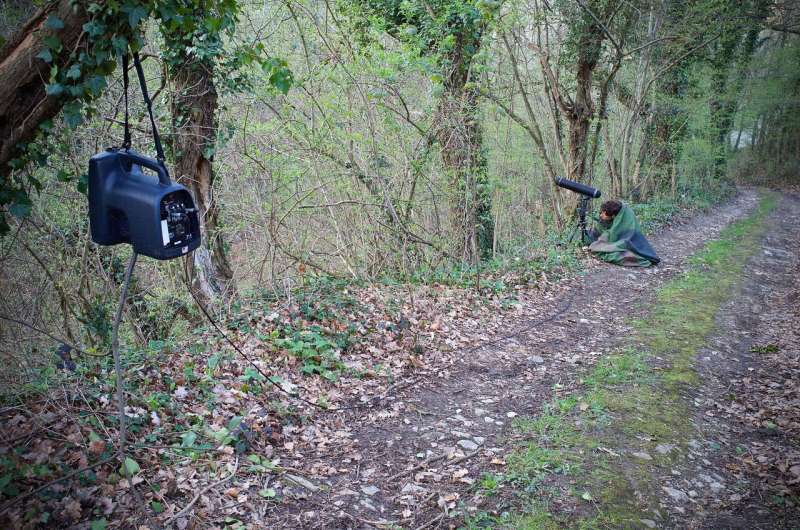Great spotted woodpecker during the field experiment. Credit: Alain Blanc, ENES team
Animal acoustic signals are amazingly diverse. Researchers from the University of Zurich and the University of Saint-Etienne, together with French, American and Dutch collaborators, explored the function and diversification of animal acoustic signals and the mechanisms underlying the evolution of animal communication systems.
To this end, they used Shannon and Weaver's "Mathematical Theory of Communication," originally applied to telecommunications in 1949, which has transformed the scientific understanding of animal communication. This theory allows the amount of information in a signal to be quantified. The researchers were the first to use this framework within an evolutionary perspective to explore the biological information encoded in an animal signal.
How drumming structure evolves over time
In deciding which biological model to choose, the researchers selected the woodpeckers' drumming as their ideal candidate. This bird family is known for rapidly striking their beaks on tree trunks to communicate. The team combined acoustic analyses of drumming from 92 species of woodpeckers, together with theoretic calculations, evolutionary reconstructions, investigations at the level of ecological communities as well as playback experiments in the field.
"We wanted to test whether drumming has evolved to enhance species-specific biological information, thereby promoting species recognition," says lead author Maxime Garcia of the UZH Department of Evolutionary Biology and Environmental Studies.
The researcher performing an acoustic playback experiment on a great spotted woodpecker. The loudspeaker is attached on a branch. Credit: Alain Blanc , ENES team
Constant amount of information for 22 million years
Results demonstrate the emergence of new drumming types during woodpeckers evolution. Yet, despite these changes in drumming structure, the amount of biological information about species identity has remained relatively constant for 22 million years. Selection toward increased biological information thus does not seem to represent a major evolutionary driver in this animal communication system. How, then, can biological information be concretely maintained in nature?
Analyses of existing communities around the globe show that ecological arrangements facilitate the efficiency of drumming signals: Communities are composed of only a few species, which distribute their drumming strategies to avoid acoustic overlap. "The responses to different drumming structures seen in our experimental approach show the ability of individuals to recognize their own species based on acoustic cues about species identity found in drumming signals," says Garcia. Thus, biological information about species identity can be maintained without necessarily inducing a strong evolutionary pressure on drumming signals.
The present study shows that random and unpredictable changes in the structure of communication signals over time can occur while maintaining the signals' overall informative potential within and across species. This work leads the way to further investigate the evolution of meaning associated with communicating through multiple communication channels.
The study is published in Nature Communications.
More information: Maxime Garcia et al. Evolution of communication signals and information during species radiation, Nature Communications (2020). DOI: 10.1038/s41467-020-18772-3
Journal information: Nature Communications
Provided by University of Zurich
























